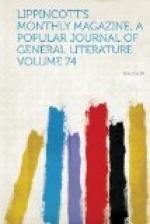On the 14th of July we were off for Fort Fetterman. To our surprise, the morning was delicious, though the mercury at noon the day before had ranged at over 100 deg. in the shade. Laramie Peak was still in sight, and was so, in fact, for weeks, till upon nearer acquaintance the fine old mountain became a friend for life. The country was still wilder and lonelier than that we had seen, and not a single habitation lay upon our route. All had been burnt by the Indians. We followed at some distance the right bank of the North Platte, all day over a barren country of low hills and scattered pines, bounded by a range of whitish bluffs beyond the river. We halted a few moments at Warm Spring, where a clear basin of tepid water bubbled and boiled and overflowed into a good-sized brook. Then on to Big Bitter Cottonwood, where we had our nooning among the trees on the wide sandy bed of the stream, which had sunk under ground for many miles, as is the custom of rivers here. It gushed forth near by, however, in copious springs, which gave us abundance of water and supported quite a luxuriant growth of vegetation. Wild currants delighted the children, clematis twined its white blossoms among the scarlet buffalo-berries, graceful osiers waved in the wind, and wild flowers were plentiful. It was a pleasant place among the wilds, and had perhaps been a happy home, for here were the ruins of a ranch burnt by the Indians. Here, too, were other ruins—of beaver-dams, built by the first settlers of all.
Leaving this creek, we went on to Little Bitter Cottonwood, a similar dry creek, but smaller and more lightly timbered. Then passing some more low hills with a few pines, always with the Platte on the right and Laramie Peak on the left, we crossed a long hill or divide called Bull Bend, and descended into the fine valley of Horseshoe Creek. We were now upon the old Overland Route to California, once so much traveled, but now deserted for the railroad. Here was the abode of Jack Slade, one of the station-masters on that famous stage-road—a man of bad reputation, and more than suspected of having been a freebooter, and even a murderer. This did not prevent his station from being one of the best on the road, his horses always good, his meals easily bolted. Of him and of his band you may read the history in Mark Twain’s Roughing It. After the railroad was finished the Indians descended upon




